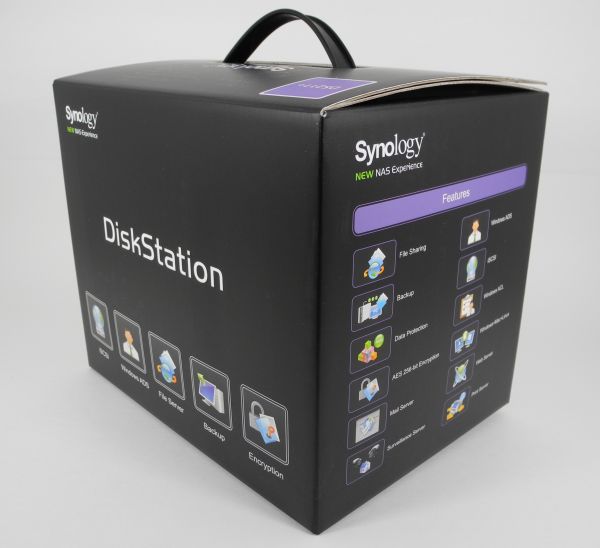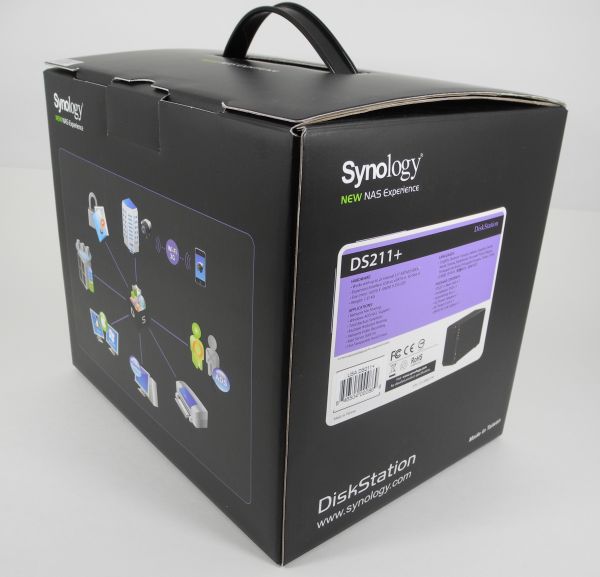Synology DS211+ SMB NAS Review
by Ganesh T S on February 28, 2011 3:50 AM EST- Posted in
- IT Computing
- NAS
- Synology
Synology is one of the rapidly rising players in the SMB (Small to Medium Businesses) / SOHO (Small Office & Home Office) NAS market. This market is a highly competitive one with many players like QNAP, Thecus, Netgear, Drobo, LaCie, Seagate and Western Digital. Consumers with a necessity to store and backup their home media collection are also amongst the customers in this market.
Synology has a sensible model number nomenclature in which the last two digits refer to the year through which the model is intended for sale. The first set of digits refer to the maximum number of bays supported. Some models have a + at the end, signifying higher performance. Today, we have the DS211+ for review. The DS refers to the product category, Disk Station. 2 indicates a 2 bay model, and the 11 indicates a 2011 model. It is supposed to have a higher performance compared to the DS211 which was released in November 2010.
The purpose of any NAS is to serve as a centralized repository for data while also having some sort of redundancy built in. The redundancy helps in data recovery, in case of media failure of any other unforeseen circumstances. Along with the standard RAID levels, some companies also offer custom redundancy solutions. The OS on the NAS also varies across vendors.
In addition to manual support for the standard RAID configurations, Synology also provides the SHR (Synology Hybrid Raid) option. The OS on the DS211+ is the Disk Station Manager 3.0 (DSM), a Linux variant. Most of its features for day-to-day operations can be accessed over a web browser.
The last SMB NAS that we reviewed was the LaCie 5big Storage Server, a 5 bay model running Windows Storage Server 2008. We introduced our new NAS benchmarking methodology in that review. In addition to repeating the methodology on the DS211+, we also checked up a little bit on the Linux performance. Before we get to that, however, let us devote a couple of sections to the hardware and software that make up the DS211+.












49 Comments
View All Comments
Rainman200 - Monday, February 28, 2011 - link
I've been a long time Synology user so I'm pretty familiar with the strengths and weaknesses of the platform. All things considered you did cover most areas fairly well in the review but Synologys major weak spot is their DLNA server and iTunes service.The DLNA server is their own in house variant but it has languished over the past year or two and compatibility has gotten steadily worse though thats not exactly Synologys fault as the AV vendors (Sony, Panasonic, Samsung etc) produce all sorts of DLNA devices with little changes that break functionality.
The iTunes service is the abandoned mt-daapd/firefly service which isn't really that useful at all and has been replaced by forked-daadp but Synology have not implemented it.
I strongly recommend anyone doing network media playing use a samba capable media player.
Lastly about Synology itself;
* The wiki is often out of date.
* Synology themselves rarely ever let users know whats coming down the pipeline in fixes/firmware updates until they release a beta.
* New features are usually poorly explained to users.
* They only release maybe one or two firmware updates in a year.
* Their own English forum isn't that helpful (Synology employees seem to prefer to avoid posting comments in most areas) in comparison the German Synology forum is much more active.
All that said they do produce some of the fastest samba NAS you can get with a nice GUI.
7Enigma - Tuesday, March 1, 2011 - link
Thanks for the great comment. This is why I love Anandtech so much.ypsylon - Monday, February 28, 2011 - link
Who in the right frame of mind would require such solution at home. 2 drive bays, max 2x2TB over RJ-45... Running RAID0 is pretty much out of the question, because whole point of external storage is backup/redundancy. With USB3 now and Thunderbolt just around the corner, small NAS solutions are totally bonkers. NAS is the only option for unattended backups with much more disks and data (in large networks). At home waiting for transfer (e.g.) simple movie file over Ethernet will test even most patient of man. Watching HD over Ethernet is totally out of the question. And if you intend to regularly backup large amounts of data every day, it will seriously affect work flow. USB3 (or eSATA) is the only way for home when it comes to small scale storage/backup. Transfers will reach easily 125MB/s with only 2 drives. Add another 2 disks for RAID10 or 5 and up to 200 MB is not a problem. No need for expensive RAID cards or NAS at home.Visual - Monday, February 28, 2011 - link
WTF are you on about?HD over Ethernet is no problem at all, what with Gbps rates now and all. Hell, HD over a 54Mbps ancient wifi is no problem at all too, as the files are compressed.
USB3 or eSATA would only make the disks accessible by one computer, not by a home network. After that, you will still rely on Ethernet for access from the rest of your home. And you have to keep that one computer in which the disks are plugged always on, essentially turning it in a NAS box. Except a hot and noisy one in all likelihood, exactly what this solution is meant to replace.
jmelgaard - Monday, February 28, 2011 - link
"because whole point of external storage is backup/redundancy"No... The point of Network Attached Storage is to Share Storage...
conejo99 - Monday, February 28, 2011 - link
Exactly, I have a DS411j that I use as a central source for three popcorn hour media players and several PCs. I actually use my PC hard drives as a backup for the NAS.dcaxax - Monday, February 28, 2011 - link
Are you mental? Why do you talk nonsense as if you have a clue and mislead other users?Running RAID0 is not out of the question, though it is pretty pointless since they device will easily stream 2 1080p videos concurrently even when using 2 low power green drives over gigabit ethernet...
USB 3 and Thunderbolt are technologies that will likely never e put onto NAS systems or any other type of server except to connect external drives to that system.
The average home network can easily benefit from unnatended backups of user files, photos, music etc on such a small NAS and as far as lanrge networks go, they are very unlikely to use NAS but more likely to go to a SAN or some enterprise class solution.
There is no problem at all with "workflow" or whatever you mean by that.
At home streaming or just plain downloading any 1080p movie is fine over ethernet, especially Gigabit.
Basically everything you say is wrong! Do us all a favor and don't talk about things you have no clue about.
Exelius - Monday, February 28, 2011 - link
So performance of Synology devices is SIGNIFICANTLY better than cheap NAS solutions from a company like WD that you may be used to. Synology makes good hardware. And 125MB/s is more than adequate for home usage; it's a hell of a lot faster than the write speed of whatever computer you're copying the file to.HD streams don't take that much bandwidth. I can stream 720p over a cable modem. Home users often significantly overestimate their bandwidth... USB3 or Thunderbolt aren't going to improve drive speeds, which is where the real bottlenecks are. Hell, it takes a 9 spindle SATA RAID5 to saturate iSCSI over gigabit ethernet.
BigMik3 - Saturday, March 17, 2012 - link
Oh my gawd I must be bonkers. I use Syno NAS at home. Store all my media on it including HD content, music, photos so that I can watch anywhere in the house via XBMC and media clients built into Panny TV/Samsung TV. Use it as centralised backup server for 3 PCs and Macs (time machine). It all works like a dream.Me Bonkers? Ypsylon - you need to take a look in the mirror!
jabber - Monday, February 28, 2011 - link
I saw 'Security Centre' mentioned somewhere.Does it have encryption on the drives? I install a lot of NAS boxes for real world customers and in the real world they don't give a damn about disk or network transfer speeds.
What they do care about is their data being encrypted within company guidlines so if the kit is stolen they don't get sued.
So I ask again if a NAS has encryption facilities please can you cover that and also how its implemented.